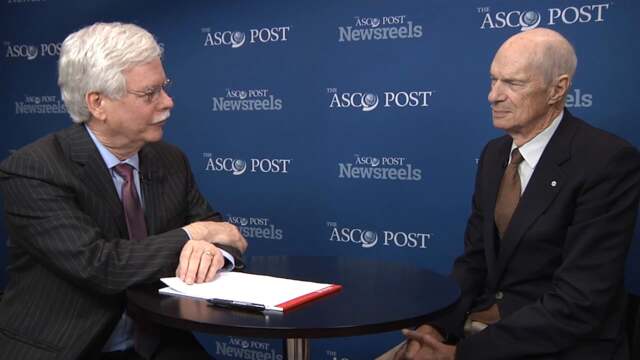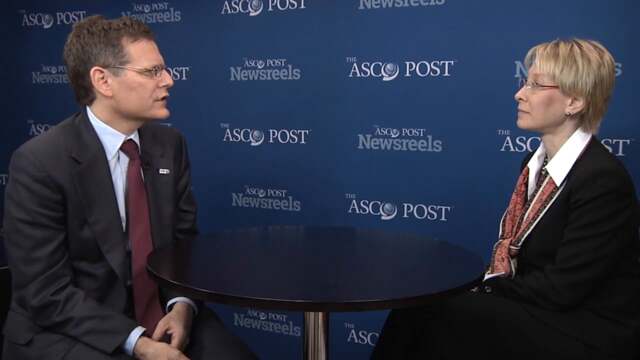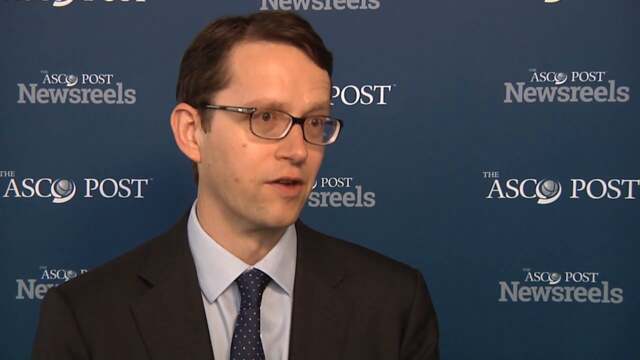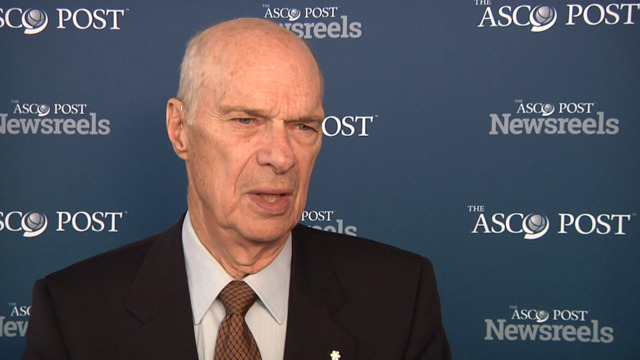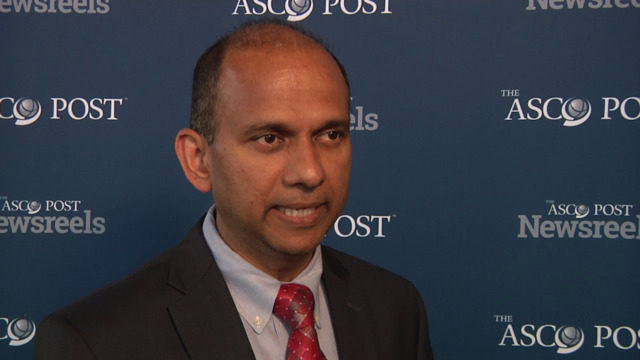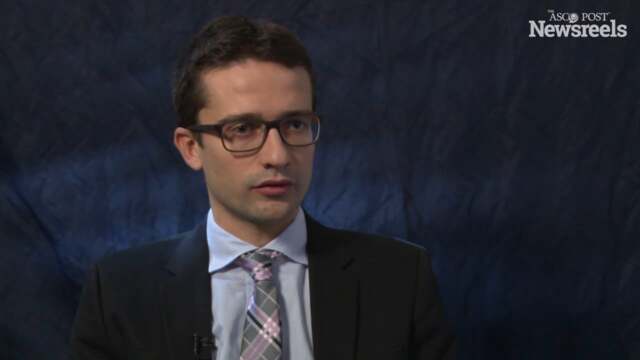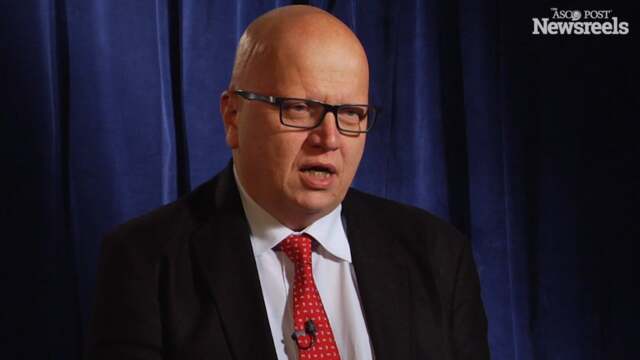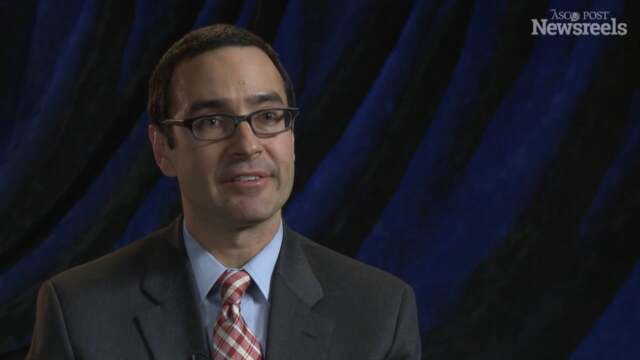Melinda Telli, MD, on Evolving Treatment Strategies for Triple-Negative Breast Cancer
Melinda Telli, MD, of Stanford Cancer Institute, discusses the TNT trial for triple-negative breast cancer and the results reported at the San Antonio Breast Cancer Symposium.
Amy Cyr, MD on Advances in Management of Early-Stage Breast Cancer
Amy Cyr, MD, of the Siteman Cancer Center at Barnes-Jewish Hospital and Washington University School of Medicine, discusses advances made in the treatment of early-stage breast cancer: less radiation and a shorter course, the rising use of molecular profiling, and less invasive surgery and reduced amounts of surgery.
Nicholas C. Turner, MD, PhD, and Clifford A. Hudis, MD, on Results of the PALOMA3 Study on Hormone Receptor–Positive, HER2 Negative Metastatic Breast Cancer
Clifford A. Hudis, MD, of Memorial Sloan Kettering Cancer Center, and Nicholas C. Turner, MD, PhD, of the Royal Marsden Hospital NHS Trust, discuss fulvestrant and palbociclib as a treatment option in pre- and postmenopausal women with hormone receptor–positive, HER2-negative metastatic breast cancer that has progressed on prior endocrine therapy (Abstract LBA502).
Richard G. Margolese, MD, and Robert W. Carlson, MD, on NSABP B-35 Trial Results for Postmenopausal Women With DCIS
Robert W. Carlson, MD, of the National Comprehensive Cancer Network, and Richard G. Margolese, MD, of McGill University, discuss the improvement in breast cancer–free interval with anastrozole vs tamoxifen in patients with ductal carcinoma in situ undergoing lumpectomy plus radiotherapy (Abstract LBA500).
Andrew D. Seidman, MD, and Clifford A. Hudis, MD, on Breast Cancer Decision Analysis
Clifford A. Hudis, MD, and Andrew D. Seidman, MD, of Memorial Sloan Kettering Cancer Center, discuss the use of the decision support system Watson for Oncology and results of the iCanCare study on second opinions (Abstracts 566 and 6508).
Julie Gralow, MD, and Clifford A. Hudis, MD, on Bisphosphonates as Adjuvant Therapy in Primary Breast Cancer
Julie Gralow, MD, of the University of Washington/Seattle Cancer Care Alliance, and Clifford A. Hudis, MD, of Memorial Sloan Kettering Cancer Center, discuss this important SWOG trial and why oral bisphosphonates should be made available in the United States (Abstract 503).
Maura N. Dickler, MD, and Clifford A. Hudis, MD, on Results From the CALGB Alliance Trial on Hormone Receptor–Positive Advanced Breast Cancer
Clifford A. Hudis, MD, and Maura N. Dickler, MD, of Memorial Sloan Kettering Cancer Center, discuss adding bevacizumab to letrozole as a first-line endocrine therapy for treatment of hormone receptor–positive advanced breast cancer (Abstract 501).
Nicholas C. Turner, MD, PhD, Summarizes Results of the PALOMA3 Breast Cancer Study
Nicholas C. Turner, MD, PhD, of the Royal Marsden Hospital NHS Trust, discusses fulvestrant and palbociclib as a treatment option in pre- and postmenopausal women with hormone receptor–positive, HER2-negative metastatic breast cancer that progressed on prior endocrine therapy (Abstract LBA502).
Richard G. Margolese, MD, Summarizes NSABP B-35 Trial Results for Postmenopausal Women With DCIS
Richard G. Margolese, MD, of McGill University discusses the improvement in breast cancer-free interval with anastrozole vs tamoxifen in patients with DCIS undergoing lumpectomy plus radiotherapy (Abstract LBA500).
Jame Abraham, MD, Summarizes Results From the NeoSphere and ExteNET Trials for Breast Cancer
Jame Abraham, MD, of the Cleveland Clinic discusses analyses of two trials for locally advanced, inflammatory, or early HER2-positive breast cancer using docetaxel, trastuzumab, pertuzumab, and neratinib (Abstracts 505 and 508).
Clifford A. Hudis, MD, on Results of the TAILORx Clinical Trial
Clifford A. Hudis, MD, of Memorial Sloan Kettering Cancer Center, discusses this prospective study of endocrine therapy alone in patients with ER-positive, HER2-negative, node-negative breast cancer (Abstract 5BA).
Matti S. Aapro, MD, on Geriatric Oncology: A Multidisciplinary Approach for Positive Outcomes
Matti S. Aapro, MD, of IMO Clinique de Genolier, offered a case presentation and a cross-disciplinary approach to finding the best way to effect a cure with minimal impact on quality of life.
Matteo Lambertini, MD, on Preserving Women’s Fertility Through Hormonal Therapy
Matteo Lambertini, MD, Dana-Farber Cancer Institute, discusses the use of LHRH agonists during chemotherapy to suppress ovarian function as a way to preserve fertility in breast cancer patients (Abstract 1957).
Lisa Carey, MD, on Molecular Screening for Breast Cancer
Lisa Carey, MD, of the University of North Carolina, discusses heterogeneity, treatment response, and outcome in HER2-positive breast cancer.
Reshma Jagsi, MD, DPhil, on the Initial Results of the TBCRC 024 Study on Breast Cancer
Reshma Jagsi, MD, DPhil, of the University of Michigan Health System, discusses this multicenter phase 1 study of veliparib given concurrently with chest wall and nodal radiation therapy in patients with inflammatory or locoregionally recurrent breast cancer (Abstract 312).
Robert Kuske, MD, on PROMIS Registry Results
Robert Kuske, MD, of Arizona Breast Cancer Specialists, discusses the evaluation of more than 1,300 patients with accelerated partial-breast irradiation via multicatheter interstitial brachytherapy, focusing on toxicity and cosmetic outcomes (Abstract 133).
Catherine C. Park, MD, on Novel Clinical Paradigms
Catherine C. Park, MD, of the University of California, San Francisco, summarizes results from three clinical trials of radiation therapy for various cancers: metastatic melanoma, oropharyngeal squamous cell carcinoma, and breast cancer (Abstracts 215, 3, and LBA7).
Vratislav Strnad, MD, PhD, on Multicatheter Brachytherapy After Breast-Conserving Surgery
Vratislav Strnad, MD, PhD, of the University Hospital in Erlangen, discusses results from a European study comparing accelerated partial-breast irradiation using brachytherapy, to the standard treatment of whole-breast irradiation for women with low-risk breast cancer (Abstract LBA7).
Jay Harris, MD, on Making Sense of Conflicting Data on Breast Irradiation
Jay Harris, MD, of Dana-Farber Cancer Institute and Brigham and Women’s Hospital, discusses the difficulty reconciling recent important trials on radiotherapy for breast cancer: The Z11 trial suggested that breast tangents are sufficient, while MA.20 and EORTC studies suggested that full nodal irradiation is beneficial.
Craig E. Pollack, MD, on Low-Income Breast Cancer Survivors: Clinical Trial Results
Craig E. Pollack, MD, of Johns Hopkins University, discusses a study of survivorship care plans for this special population (Abstract 1).
Jennifer A. Ligibel, MD, on Breast Cancer Survivorship in Young Women
Jennifer A. Ligibel, MD, of the Dana-Farber Cancer Institute, discusses the physical activity behaviors and weight changes in a study cohort of young women with breast cancer (Abstract 166).
USPSTF Recommendation Confirms Value of Screening Mammography
The recently updated U.S. Preventive Services Task Force (USPSTF) recommendation once again confirmed the value of screening mammography, concluding that the benefit of mammography outweighs the harms of screening in all age groups from age 40 through age 74. It emphasizes that both women and...
Mastectomy Healed by Earth Dressing
Through the Lens of Oncology History A Century of Progress The text and photographs on this page are excerpted from a four-volume series of books titled Oncology Tumors & Treatment: A Photographic History, by Stanley B. Burns, MD, FACS. The photos below are from the volume titled “The...
A Noted Breast Surgeon’s Book of Solid Advice
Bookmark Title: The New Generation Breast Cancer Book: How to Navigate Your Diagnosis and Treatment Options—and Remain Optimistic—in an Age of Information Overload Author: Elisa Port, MD Publisher: Ballantine Books Publication date: September 2015 Price: $20.00; paperback, 320 pages When a new...
Study Reveals Potential Therapy Targets for Triple-Negative Breast Cancer
A multi-institutional international investigation led by scientists at The University of Texas MD Anderson Cancer Center, Houston, has revealed new information about how molecules called long noncoding RNAs (lncRNA) interact with HIF-1, a signaling pathway that is overexpressed in many cancers....
New Society of Breast Imaging Website Seeks to End Confusion Surrounding Mammography Screening
Breast cancer is the second-leading cause of cancer deaths among women in the United States. In 2015, according to the National Cancer Institute, 231,840 women were to be diagnosed with the disease and 40,290 were to die from it. The death rate is highest among women who are not screened regularly...
The New Frontiers of Breast Cancer
A seismic shift is underway in screening and treatment approaches for breast cancer. These changes are being fueled by studies showing that mammography in younger women may do more harm than good and that advances in genomic testing and a better understanding of the biology of breast cancers may...
International Innovation Grant Supports Novel Breast Cancer Health Education Program in Mexico
The International Innovation Grant, funded by the Conquer Cancer Foundation (CCF) of ASCO, provides research funding in support of novel and innovative projects that can have a significant impact on cancer control in low- and middle-income countries. The grant is intended to support research that...
Exploratory Analysis of ExteNET Trial Shows Consistency of Benefit With Neratinib
An exploratory analysis of the ExteNET study of neratinib in early HER2-positive breast cancer after treatment with trastuzumab (Herceptin) upheld the findings previously reported for the 2-year analysis, according to the study’s principal investigator Arlene Chan, MD, of the Breast Cancer...
Homologous Recombination Deficiency Score Correlated With Response to Platinum in Breast Cancer
The homologous recombination deficiency (HRD) score may be a predictive biomarker of response to neoadjuvant platinum-based therapy in patients with triple-negative breast cancer, according to studies presented at the 2015 San Antonio Breast Cancer Symposium. “We found, in our adjusted analysis,...
Role of Carboplatin in Triple-Negative Breast Cancer Still Unclear
Studies presented at the 2015 San Antonio Breast Cancer Symposium built upon an increasing body of data in support of the neoadjuvant use of carboplatin in patients with triple-negative breast cancer. Overall, however, the studies fell short of establishing carboplatin’s role in this malignancy and ...
Immunotherapy for Breast Cancer: Early Lackluster Study Results yet Promise Remains
Immunotherapy is at the forefront of exciting new approaches to cancer, with excellent and long-lasting responses in metastatic melanoma and non–small cell lung cancer (NSCLC) and several immunotherapy agents now approved for those malignancies by the U.S. Food and Drug Administration (FDA). The...
Prophylactic Beta-Blocker Preserves Left-Ventricular Function in Patients Receiving Trastuzumab
The beta-blocker bisoprolol was able to prevent trastuzumab (Herceptin)-associated declines in left-ventricular ejection fraction, whereas the effect of the angiotensin-converting–enzyme (ACE) inhibitor perindopril was less robust. Use of bisoprolol reduced dose interruptions for trastuzumab due to ...
Surgical Margin Width Not Related to Breast Cancer Recurrence
The width of the surgical margin doesn’t matter, as long as the margin is negative, according to a large study of breast-conserving surgery in patients with invasive breast cancer. The risk of ipsilateral breast tumor recurrence was similar for wide negative margins (2–4 mm) or narrow negative...
PI3K Inhibitor Buparlisib Extends Progression-Free Survival in Advanced Breast Cancer
Addition of the oral investigational pan-PI3K inhibitor buparlisib to the endocrine agent fulvestrant (Faslodex) improved progression-free survival among postmenopausal women with advanced hormone receptor–positive/HER2-negative advanced breast cancer. “We are happy to announce that the phase III...
Ado-Trastuzumab Emtansine Improved Overall Survival for Heavily Pretreated Patients With HER2-Positive Breast Cancer
Among patients with HER2-positive, metastatic breast cancer that had progressed despite treatment with two or more forms of HER2-targeted therapy (trastuzumab [Herceptin] and lapatinib [Tykerb]), median overall survival was increased for those treated with ado-trastuzumab emtansine (aka T-DM1...
Plasma-Based Test Identifies Impactful Mutations in BOLERO-2 Population
A plasma-based cell-free DNA test identified mutations in the estrogen receptor 1 gene (ESR1) in 30% of patients from the BOLERO-2 trial of everolimus (Afinitor) plus exemestane, and these mutations were correlated with survival. The results, which support the use of plasma as a source of...
Neoadjuvant Palbociclib Enhances Effect of Anastrozole on Complete Cell-Cycle Arrest
The cyclin-dependent kinase (CDK) 4/6 inhibitor palbociclib (Ibrance) enhanced cell-cycle control over that achieved with anastrozole alone in a study that evaluated the drugs’ ability to induce complete cell-cycle arrest in tumor cells and to produce clinical responses, as neoadjuvant therapy for ...
Study Suggests Luminal A Breast Cancer Patients May Not Need Chemotherapy
The ability to classify breast cancer according to biologic subtype has enabled researchers to dig deeper and determine which therapies benefit specific subgroups. Encouraging evidence from an analysis of a Danish trial presented at the 2015 San Antonio Breast Cancer Symposium suggests that...
Risk Factors for Lymphedema in Patients Treated for Breast Cancer
In a study reported in the Journal of Clinical Oncology, Ferguson et al found that cellulitis in the affected arm, but not blood draws, injections, trauma to the affected arm, or air travel, was associated with an increased risk of lymphedema in women treated for breast cancer. Study Details In...
UK Study Suggests Association Between Screen-Detected Ductal Carcinoma in Situ and Reduced Invasive Interval Breast Cancers
In a UK retrospective population-based study reported in The Lancet Oncology, Duffy et al found a significant inverse association between the detection of ductal carcinoma in situ in breast cancer screening and the incidence of invasive interval cancers diagnosed within 3 years after screening....
Study Finds Adjuvant Anastrozole Reduces Recurrence Risk vs Tamoxifen in Postmenopausal Women With Ductal Carcinoma in Situ
In a phase III trial (National Surgical Adjuvant Breast and Bowel Project [NSABP] B-35) reported in The Lancet, Margolese et al found that adjuvant anastrozole significantly improved the breast cancer–free interval vs tamoxifen in postmenopausal women with hormone receptor–positive...
No Association Seen Between New or Worsening Aromatase Inhibitor–Related Musculoskeletal or Vasomotor Symptoms and Relapse-Free Survival
Retrospective analyses of the ATAC, TEAM, and BIG 1-98 adjuvant endocrine therapy trials in breast cancer have suggested that treatment-emergent endocrine symptoms may be associated with superior survival outcomes. However, in a study reported in the Journal of Clinical Oncology, Stearns et al...
Higher Risk of Radiation-Induced Breast Cancer Found in Women Screened More Frequently and in Women With Larger Breasts
Radiation-induced breast cancer risk from digital mammography is low for the majority of women, but the risk is higher in women with large breasts, who received 2.3 times more radiation and required more views per examination to image as much of the breast as possible compared to those with small...
Use of 21-Gene Recurrence Score May Be Linked to Chemotherapy Use and Health-Care Costs in Women With Breast Cancer
In a study using Pennsylvania Cancer Registry data reported in the Journal of Clinical Oncology, Epstein et al found that use of the 21-gene recurrence score (RS) assay was associated with lower use of chemotherapy and lower medical spending among patients younger than age 55 with early-stage...
New Findings May Enhance PARP Inhibitor Therapy in Breast Cancer
Findings from a new study reveal that the activity of PARP inhibitors, an emerging class of drugs being studied in cancer clinical trials, may be enhanced by combining them with inhibitors targeting the oncogene c-MET, which is overexpressed in many cancers. The findings resulting from in vitro and ...
High Risk on Breast Cancer Risk Prediction Tools Associated With More Favorable Disease Characteristics
In a Swedish study reported in the Journal of Clinical Oncology, Holm et al found that high risk on the Tyrer–Cuzick predicted 10-year breast cancer risk score (TCRS) and a 77-single nucleotide polymorphism polygenic risk score (PRS) tended to be associated with favorable prognostic features...
Japanese Study Shows Oral Fluoropyrimidine S-1 Is Noninferior to Taxanes as First-Line Treatment of HER2-Negative Metastatic Breast Cancer
In a Japanese phase III trial (SELECT BC) reported in The Lancet Oncology, Takashima et al found that first-line treatment with the oral fluoropyrimidine S-1 was associated with noninferior overall survival vs taxane regimens in women with HER2-negative metastatic breast cancer resistant to...
Ultrasound Guidance Lowers Risks of Thoracic Nerve Block Technique for Mastectomy
A regional anesthesia technique called thoracic paravertebral nerve block is highly effective in controlling pain after breast cancer surgery, but concern about potential complications may limit its use. A new study provides evidence that using ultrasound to guide the nerve blocking procedure...
Nonsignificant Improvement in Disease-Free Survival With Adjuvant Lapatinib/Trastuzumab vs Trastuzumab in Early HER2-Positive Breast Cancer
Results of a phase III trial, reported in the Journal of Clinical Oncology by Piccart-Gebhart et al, showed a modest and statistically nonsignificant increase in disease-free survival with concurrent adjuvant lapatinib (Tykerb) and trastuzumab (Herceptin) vs trastuzumab alone in patients with...



